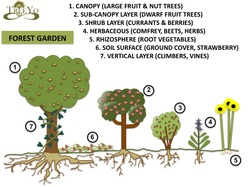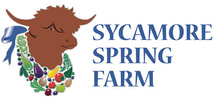“The nation that destroys its soil destroys itself.” – Franklin D. Roosevelt
Permaculture design seeks to minimize waste, human labor, and energy input by building systems with maximal benefits between design elements to achieve a high level of synergy. Permaculture designs evolve over time by taking into account these relationships and elements and can become extremely complex systems that produce a high density of food and materials with minimal input.

Permaculture draws from several disciplines including organic farming, agroforestry, integrated farming, sustainable development, and applied ecology.
Layering is a key tool used to design functional ecosystems that are both sustainable and of direct benefit to man.
A mature ecosystem has a huge number of relationships between its component parts: trees, understory, ground cover, soil, fungi, insects, and animals. Because plants grow to different heights, a diverse community of life is able to grow in a relatively small space, as each layer is stacked one on top of another.
There are generally seven recognized layers in a food forest, although some practitioners also include fungi as an eighth layer
Soil Assessment
We assess the living biology of your soil so that you can make plants and animals grow faster, stronger, and healthier.
What is the Soil Food Web? The soil food web is the community of organisms living in the soil. It is the science that describes the complex living system in the soil and how it interacts with the environment.
How does it help? Having healthy diverse populations or soil micro/macro organisms builds soil fertility and organic matter. This makes it easier for plants to do well and thrive..
Results you will see by improving soil biology:
§ Increased soil depth and structure
§ Decrease inputs (i.e. feed costs, fertilizer)
§ Increased productivity
§ Reduced or eliminated use of herbicides and pesticides
§ Balanced soil pH
§ Increased soil moisture retention
§ Strong, nutrient-rich, deeply-rooted plants
§
How do we work together?
We start with soil sample(s). Your soil samples are reviewed under the microscope to assess the active biology. We will determine the relative numbers and diversity of bacteria, fungi count, protozoa and nematodes. We then create a written qualitative assessment and recommendations to boost the soil biology for greater plant growth and resilience.
How do we start?
Give us a call or send an email and tell us how to get in touch. We’ll have a conversation about what we can accomplish together. We can put in edible specimen plants, plan and plant a garden, design an orchard or begin to grow a multi year, multi tiered food forest. Do not put off another year getting started on one of the best investments you will ever make, a project that can produce food for a lifetime.
Layering is a key tool used to design functional ecosystems that are both sustainable and of direct benefit to man.
A mature ecosystem has a huge number of relationships between its component parts: trees, understory, ground cover, soil, fungi, insects, and animals. Because plants grow to different heights, a diverse community of life is able to grow in a relatively small space, as each layer is stacked one on top of another.
There are generally seven recognized layers in a food forest, although some practitioners also include fungi as an eighth layer
- The Canopy: the tallest trees in the system. Large trees dominate but do not saturate the area, i.e. there exist patches barren of trees.
- Understory layer: trees that usually grow less than 45'
- Shrubs: a diverse layer that includes most berry bushes
- Herbacious: may be annuals, biennials or perennials; most annuals will fit into this layer
- Soil surface: cover crops to retain soil and lessen erosion, along with green manures to add nutrients and organic matter to the soil, especially nitrogen
- Rhizosphere: root crops including potatoes, sun-chokes and other edible tubers
- Vertical layer: climbers or vines such as climbing or running beans and lima beans (vine varieties)
Soil Assessment
We assess the living biology of your soil so that you can make plants and animals grow faster, stronger, and healthier.
What is the Soil Food Web? The soil food web is the community of organisms living in the soil. It is the science that describes the complex living system in the soil and how it interacts with the environment.
How does it help? Having healthy diverse populations or soil micro/macro organisms builds soil fertility and organic matter. This makes it easier for plants to do well and thrive..
Results you will see by improving soil biology:
§ Increased soil depth and structure
§ Decrease inputs (i.e. feed costs, fertilizer)
§ Increased productivity
§ Reduced or eliminated use of herbicides and pesticides
§ Balanced soil pH
§ Increased soil moisture retention
§ Strong, nutrient-rich, deeply-rooted plants
§
How do we work together?
We start with soil sample(s). Your soil samples are reviewed under the microscope to assess the active biology. We will determine the relative numbers and diversity of bacteria, fungi count, protozoa and nematodes. We then create a written qualitative assessment and recommendations to boost the soil biology for greater plant growth and resilience.
How do we start?
Give us a call or send an email and tell us how to get in touch. We’ll have a conversation about what we can accomplish together. We can put in edible specimen plants, plan and plant a garden, design an orchard or begin to grow a multi year, multi tiered food forest. Do not put off another year getting started on one of the best investments you will ever make, a project that can produce food for a lifetime.
